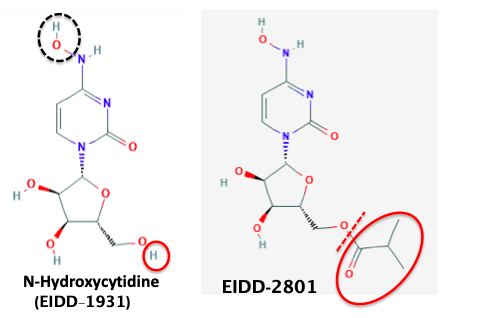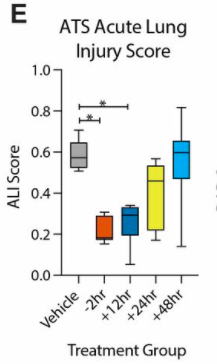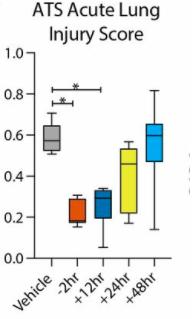Press briefings, by any measure, are long and loud. And now they may get longer and louder since there is another potential antiviral drug to yell about.
It is called β-D-N4-hydroxycytidine, but N-hydroxycytidine or NHC are fine too. So is EIDD-1931. NHC has some intriguing properties that might make it, at least for now, a very promising weapon against coronavirus. These include:
- Potency
- Little cellular toxicity
- Known mechanism of action
- Ease of synthesis
- Oral administration with good bioavailability (the drug gets into the blood)
A group from UNC Chapel Hill, Vanderbilt, Emory, and the CDC Division of Viral Diseases published a paper in the journal Science Translational Medicine that reports the antiviral properties of NHC against a number of coronaviruses; the drug appears to be capable of handling all of them.

Figure 1. The chemical structures of cytidine (L) and NHC (R). The two differ only by the hydroxy group (black hatch circle). That hydroxy group makes a helluva difference.
PROPERTIES OF NHC
1. Antiviral activity
NHC inhibits the replication of MERS, the "original" SARS, and SARS-CoV-2 (aka "novel coronavirus") in cultured cells. The drug inhibits half of the viral replication (the EC50) at low concentrations. The lower the concentration, the more potent the drug is. Here are some EC50 values from the paper:
MERS (in human lung epithelial cells) 0.15 µM (micromolar). This is a potent inhibition.
SARS-CoV-2 ("coronavirus") 0.08 µM, 0.09 µM. There are two numbers because the virus was measured in two similar ways. NHC is a potent (perhaps, very potent – it's a subjective term) inhibitor of SARS-CoV-2.
While it is not possible to accurately rank potential antiviral drugs by simply comparing EC50 values from different labs that may use different cell cultures, these numbers can serve as an indicator of relative potency.
This table incorporates the EC50 values (in micromolar (µM)) of NHC and the other experimental drugs I have written about (1). The lower the number the more potent the drug.
- NHC, 0.08, 0.09
- Remdesivir - 0.1, 0.77
- Favipiravir - 62
- Hydroxychloroquine - 0.77
- Chloroquine - 0.77, 1.1, 5.42
From this data, one can conclude that 1) some of these numbers are nuts; 2) NHC appears to be about as potent as remdesivir and significantly more so than the others.
2. Selectivity
I'm betting that the EC50 of bleach would be a whole lot lower than any experimental drug. But I'm going to assume that you know that it's not a great idea to drink it. So here's a little thought experiment. A company is screening thousands of compounds to look for anything with antiviral properties. Here's (roughly) what the data might look like:
COMPOUND # EC50 (µM)
124 >10
125 3.3
126 0.09
127 0.00001
So, when the biologist sees the data for #127 he/she is going to go absolutely bats##t and call his chemistry counterpart with one hand (to find out what this SUPERINHIBITOR is) while picking out his favorite color BMW with the other. OK, it is extremely unlikely that bleach is going to be part of any chemistry library of test compounds, but let's say #127 is something that is highly toxic. This is why the CC50 (cytotoxic concentration) – the concentration of the compound that kills 50% of the cells is critical. A toxic compound – one that will kill cells – will also show up as a potent antiviral because viruses will only replicate in living, healthy cells. So, a toxin will show up as a false positive – it is killing the cells, not the virus.
Now, let's add the CC50 and selectivity index (SI). Things look very different.
COMPOUND # EC50 (µM) CC50 (µM) SI
124 >10 >100 >10
125 3.3 9.5 2.8
126 0.09 >10 >111
127 0.00001 0.00001 1
When these results are taken together the following conclusions can be reached:
- #124 is not toxic but does not inhibit the virus. Flush it.
- #125 is a weak inhibitor and has cellular toxicity at nearly the same concentration as the EC50. Flush it.
- #126 is a potent inhibitor with no cellular toxicity at a concentration that is more than 111-times the EC50. #126 is an interesting compound.
- #127 is bleach (or something similarly toxic). Although it stops viral replication at an absurdly low EC50 this is an artifact. #127 is killing the assay cells. Flush it. Twice.
3. "Decorating" the molecule
NHC may be a great drug, but it's a lousy pill (doesn't work when taken orally). Although the authors do not provide details about how lousy it is, this can be implied (emphasis mine):
Here, we report the broad-spectrum antiviral activity of NHC and its orally bioavailable prodrug EIDD-2801, against SARS-CoV, MERS-CoV, and the current pandemic strain SARS-CoV-2 in primary human airway epithelial cells
EIDD-2801 sounds a lot different than NHC but they are actually quite similar (Figure 2):

Figure 2. NHC contains three hydroxyl (OH) groups, which makes it highly polar and water-soluble. In general, lipophilic (fat-loving) molecules are better absorbed by the gut while hydrophilic (water-loving) are not. A one-step chemical reaction called esterification does the job quite nicely. Converting one of the hydroxyl groups to its isobutyrate ester (red oval) gives EIDD-2801, a pro-drug of NHC (2). Esters are common pro-drugs because they are usually absorbed in the gut and then metabolized by enzymes in the blood, releasing the active drug. The bond that is broken is represented by the red hatch line. Thanks to the pro-drug, all of a sudden there is a bunch of NHC in the blood – exactly where it needs to be. So, EIDD-2801 can be a pill instead of an injection.
4. Efficacy in mice
If a drug can prevent deaths in rodent models of infection, and also reduce the amount of virus formed, it is a fairly good bet that it will show some effect in humans. Animal models of infection are usually pretty decent compared to those of other diseases. (Keep in mind that remdesivir was tested in monkeys - a much better model.)
There are pages of data covering four mouse experiments. Here is a brief (and incomplete) summary.
Five parameters of efficacy were used to measure whether the drug inhibited the virus:
- Loss of body weight (a sign of illness in the mouse)
- Pulmonary function
- Lung hemorrhage
- The amount of virus in the lungs
- Lung damage
In every case, EIDD-2801 worked better when it was administered prior to infection. But there also seemed to be a 12-hour window following infection when the drug worked about as well. Here is one example (acute lung injury, Figure 3).

Figure 3. The impact of the timing of the first dose of drug on lung damage in mice after 5 days. The gray group received vehicle only and had the worst (highest) score ~0.6. The orange group (the animals dosed two hours before infection) has the least lung damage, but the dark blue group, which received drug 12 hours following infection had a similar amount of damage. The yellow group, which was dosed 24 hours post-infection sustained significantly more damage, while the light blue group (dosed 48 hours post-infection) suffered as much damage as non-treated mice. Image: Science Translation Medicine
This effect was also seen in the other parameters – good prophylactic protection and a fairly strict post-infection interval (12 hours) of time of protection, after which time the drug became less and less effective.
This timeline makes sense. It suggests there is a 12-hour interval during which time the virus has been acquired and is (presumably) starting to enter cells but not yet replicating at full tilt. At least in mice, this is the window when the drug will be most effective. This is consistent with the profile of other antiviral drugs, such as Tamiflu and acyclovir; the earlier they are administered the better they work. After a certain period of time, they don't.
SUMMARY
This drug seems to have a lot going for it, much of which is beyond the scope of this article. Like remdesivir it is a nucleotide analog – the most common type of antiviral drug. Unlike remdesivir, it is orally active, so it can be administered as a pill. Its potency seems to be in the same range. It seems to be non-toxic and also inhibits other coronaviruses. While remdesivir has been shown to protective in monkeys (a better model) NHC does so in mice.
PREDICTION
I have no idea. NHC looks good, but only in mice and at high doses. It will join the fray and the best drug (assuming there is one) will eventually rise to the top. No yelling necessary.
NOTES:
(1) See Chloroquine For Coronavirus? Not So Fast, Can Gilead's Remdesivir Tame The Coronavirus?, Favipiravir: Another Player In The Coronavirus Drug Sweepstakes, Coronavirus: Hydroxychloroquine Probably Isn't The Answer
(2) A pro-drug is an inactive derivative of a drug that is used to improve the pharmacokinetic properties of that drug, for example, oral absorption and bioavailability. The pro-drug is typically metabolized in the blood where it releases the active drug.




